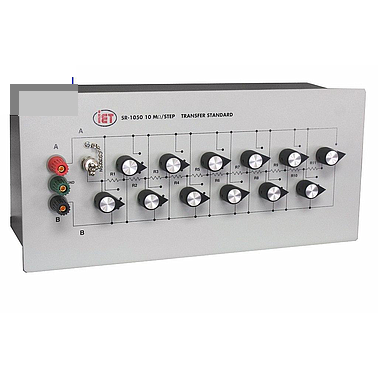
Điện trở chuẩn IETLAB SR1050 Series 1M & 10 M (± 2 ppm )
Hãng sản xuất: IET LABS Model: SR1050 Series 1M & 10 M Xuất xứ: USA (Mỹ) Bảo hành: 12 Tháng - Liên hệ
Tham khảo dịch vụ Hiệu chuẩn-Kiểm định và Sửa chữa
Gọi để có giá tốt
TP. Hà Nội: (024) 35.381.269
TP. Đà Nẵng: (023) 63.747.711
TP. Bắc Ninh: (0222) 730.39.68
TP. Hải Phòng: (0225) 730.03.89
TP. HCM: (028) 38.119.636
Đồng Nai: 0932.160.940
( Khách hàng chọn model, thông số chi tiết tại mục Datasheet, Download/video. )
Giá trị điện trở 1 MΩ & 10 MΩ
Độ chính xác ban đầu ± 25 or 30 ppm of nominal value matched within 10 ppm
Độ chính xác biến đổi ± 2 ppm (độ nhắc lại ngắn kỳ)
Độ chính xác hiệu chỉnh ± 10 hoặc 15 ppm
Transfer Accuracy Limited only by short-term repeatability of resistance values. Typical repeatability ±2 ppm
Initial Accuracy ±25 ppm of nominal value, matched within 10 ppm, for 1 MΩ, ±30 ppm of nominal value, matched within 10 ppm, for 10 MΩ
Long-Term Accuracy ±50 ppm of nominal value
Calibration Accuracy ±10 ppm for 1 MΩ; 15 ppm for 10 MΩCalibration Conditions 23 ºC, low power, three-terminal measurement
Temperature Coefficient ±5 ppm/ºC, matched within 5 ppm/ºC
Power Coefficient ±0.05 ppm/mW per resistor
Maximum Power Rating 1W/step or 5W distributed over 10 steps, or maximum voltage of 2.5 kV where this value does not result in power excess of 1W per resistor
Breakdown Voltage 5000 V peak between active terminals and case
Leakage Resistance Greater than 10 TΩ from terminals to case
For low resistance transfer standards, consider the esi SR1010 or SR1030
IET Labs continues to manufacture the SR1050 to the same exacting specs as esi/Tegam
Introduction
Each of the esi SR1050 transfer standards consists of 11 equal steps. These steps are available in increments of 1M Ω, (SR1050-1M) and 10M Ω, (SR1050-10M). The esi SR1050 provides a three terminal connection for each step or for a series of resistance steps. Specially designed lever switches separate each resistor from the others. This allows the standard to be configured in series, parallel, series-parallel, or separately without the use of external shorting bars.
Description
Precise transfer measurements up to 110 MΩ relative to a single 100 kΩ resistance standard can be obtained with the esi SR1050 High-Resistance Transfer Standards. The unit is available in two models: 1 MΩ and 10 MΩ resistance sections.
Based on a unique method for establishing known ratios, the esi SR1050 standard utilizes a transfer technique that consists of switching resistance sections in parallel, series or series-parallel sections. An outstanding design feature is a structure in which the only insulation leakage paths (other than those within each resistance section) are from the external terminals to ground. This eliminates insulation leakage errors in the transfer of calibration from one resistance level to another using three-terminal measurement techniques.
A specially designed lever switch provides a convenient means of switching into parallel and series parallel configuration without introducing insulation leakage errors. External shorting or paralleling bars are not necessary. Each resistance section consists of precision wire-wound resistors connected in series. The reduced heat concentration of the series connection improves the thermal characteristics of a resistance element with an already low temperature coefficient
Advantages of Transfer Standards
In order to perform calibrations with a high degree of accuracy, reference standards must be employed at every range or decade of the measuring or calibration instrumentation. Clearly, this can be difficult and costly since these standards must be highly stable and their precise values must be known with a high degree of certainty and sufficient resolution.
To minimize the cost and difficulty, more practical means of performing such calibrations is to use transfer standards.
If one has a single standard that is calibrated by a national laboratory, one can then compare the transfer standards to the certified standard by ratio techniques. See our Technical Applications section for a full tutorial. The Benefits of Using Transfer Standards
- Cam kết chất lượng
- Bảo hành chính hãng
- Giao hàng tận nơi
- Đơn giản hóa giao dịch
